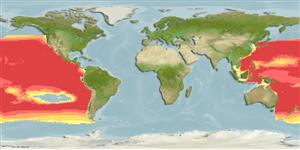Actinopterygii (ray-finned fishes) >
Myctophiformes (Lanternfishes) >
Myctophidae (Lanternfishes) > Lampanyctinae
Etymology: Lampadena: Greek, lampas, -ados = torch + Greek, aden = gland (Ref. 45335).
Issue
Issue on validity of subspecies: subspecies considered as valid in FB, elevated to species rank as Lampadena urophaos Paxton, 1963 in Eschmeyer (CofF ver. Mar. 2011: Ref. 86697). Please send references, or more studies are needed.
Environment / Climate / Range
Ecology
Marine; pelagic-oceanic; depth range 50 - 1000 m (Ref. 58302). Subtropical, preferred ?; 48°N -
Western Pacific: Suruga Bay, Japan and near the Ogasawara and Ryukyu islands. Also New South Wales, Australia (Ref. 7300) and New Zealand (Ref. 5755). Eastern Pacific: between 42°N and 25°N from the California coast to Hawaii (Ref. 4479). Recorded off British Columbia, Canada (Ref. 11980) and from Chile (Ref. 9068).
Size / Weight / Age
Maturity: Lm ? range ? - ? cm
Max length : 14.0 cm SL male/unsexed; (Ref. 559)
Epipelagic to mesopelagic (Ref. 31442) at 50-600 m at night, 500-1000 m during day (Ref. 58302). Reported from depths of 100-500 m in Subarctic Pacific gyres (Ref. 51600). Oviparous, with planktonic eggs and larvae (Ref. 31442).
Life cycle and mating behavior
Maturity | Reproduction | Spawning | Eggs | Fecundity | Larvae
Paxton, J.R., D.F. Hoese, G.R. Allen and J.E. Hanley, 1989. Pisces. Petromyzontidae to Carangidae. Zoological Catalogue of Australia, Vol. 7. Australian Government Publishing Service, Canberra, 665 p. (Ref. 7300)
IUCN Red List Status (Ref. 115185)
CITES (Ref. 94142)
Not Evaluated
Threat to humans
Harmless
Human uses
More information
ReferencesAquacultureAquaculture profileStrainsGeneticsAllele frequenciesHeritabilityDiseasesProcessingMass conversion
Tools
Special reports
Download XML
Internet sources
Estimates of some properties based on models
Phylogenetic diversity index (Ref.
82805): PD
50 = 0.5010 [Uniqueness, from 0.5 = low to 2.0 = high].
Bayesian length-weight: a=0.00933 (0.00401 - 0.02170), b=3.03 (2.82 - 3.24), in cm Total Length, based on LWR estimates for this (Sub)family-body shape (Ref.
93245).
Trophic Level (Ref.
69278): 3.2 ±0.3 se; Based on size and trophs of closest relatives
Resilience (Ref.
69278): Medium, minimum population doubling time 1.4 - 4.4 years (Preliminary K or Fecundity.).
Vulnerability (Ref.
59153): Moderate vulnerability (39 of 100) .
